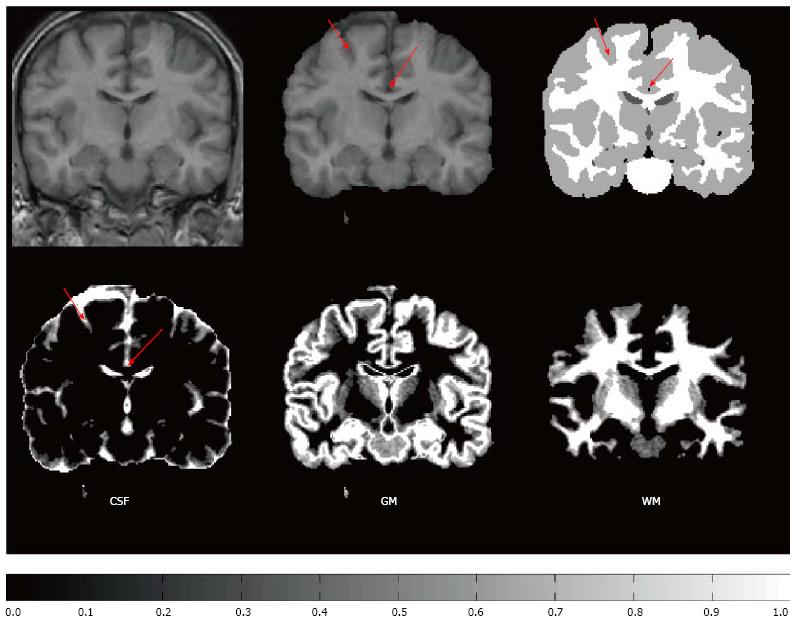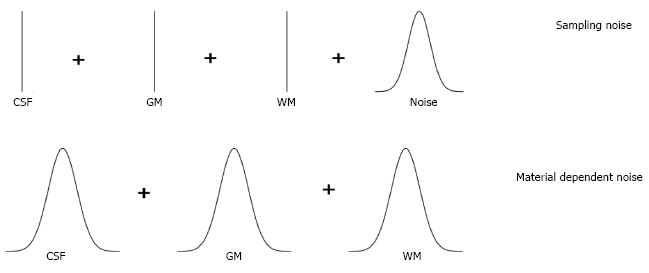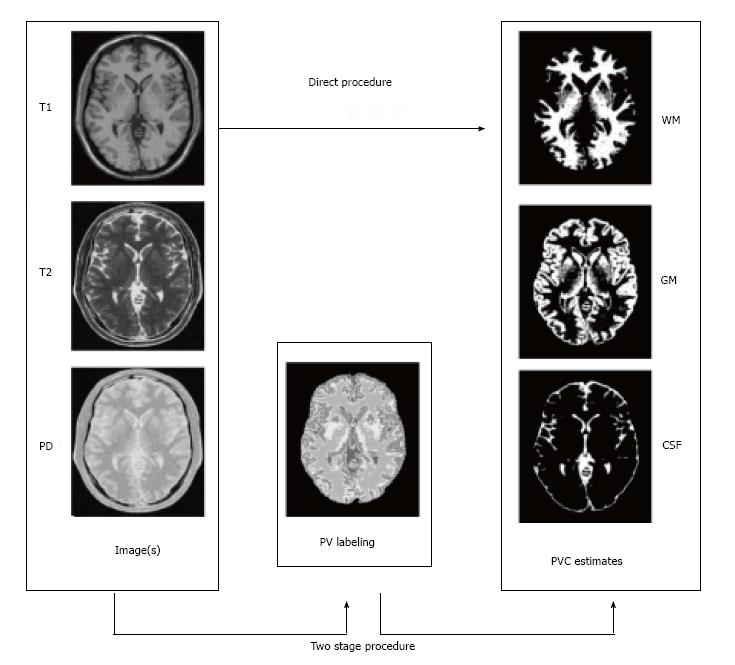Copyright
©2014 Baishideng Publishing Group Inc.
World J Radiol. Nov 28, 2014; 6(11): 855-864
Published online Nov 28, 2014. doi: 10.4329/wjr.v6.i11.855
Published online Nov 28, 2014. doi: 10.4329/wjr.v6.i11.855
Figure 1 A schematic explanation of the partial volume effect in the context of brain magnetic resonance imaging.
Voxels composed of purely gray matter (GM) are colored in black color while voxels composed of cerebro-spinal fluid (CSF) or white matter (WM) are in white color. These are termed pure tissue voxels or pure voxels. Voxels composed of multiple tissue types, termed mixed voxels, are colored in gray. In the figure, these can be either voxels containing both CSF and GM tissue types or voxels containing both WM and GM tissue types. The actual anatomical boundaries between tissue types are shown in blue and red color is used to indicate voxel boundaries.
Figure 2 Example of partial volume estimation.
Top row, from left: A coronal section of T1 weighted MR image; A skull stripped version of the coronal section; A manual labeling into gray matter (GM) (gray color), white matter (WM) (white color), and cerebro-spinal fluid (CSF) (dark gray color). Bottom row: Estimates of partial volume coefficients (PVCs) for CSF, GM, and WM. The color bar refers to the PVC estimates in the bottom row. The image is obtained from the IBSR2 dataset provided by the Center for Morphometric Analysis at Massachusetts General Hospital and PVCs were computed as described in the ref. [28]. Note how the manual hard labeling completely misses the CSF in the interhemispheric fissure as well as in the superior frontal sulcus pointed by red arrows. Instead PVC estimates of CSF in the bottom row capture well the sulcal CSF.
Math 1 Math(A1).
Math 2 Math(A1).
Figure 3 Sampling and material dependent noise models.
Sampling noise model assumes that each tissue type is represented by a single average value and Gaussian-distributed noise is then added. Material dependent noise model assumes that the tissue types are represented by random variables. CSF: Cerebro-spinal fluid; GM: Gray matter; WM: White matter.
Math 3 Math(A1).
Math 4 Math(A1).
Math 5 Math(A1).
Math 6 Math(A1).
Math 7 Math(A1).
Math 8 Math(A1).
Figure 4 Direct vs two step procedure for partial volume coefficient estimation.
CSF: Cerebro-spinal fluid; GM: Gray matter; WM: White matter; PVC: Partial volume coefficient.
Math 9 Math(A1).
Math 10 Math(A1).
- Citation: Tohka J. Partial volume effect modeling for segmentation and tissue classification of brain magnetic resonance images: A review. World J Radiol 2014; 6(11): 855-864
- URL: https://www.wjgnet.com/1949-8470/full/v6/i11/855.htm
- DOI: https://dx.doi.org/10.4329/wjr.v6.i11.855






















